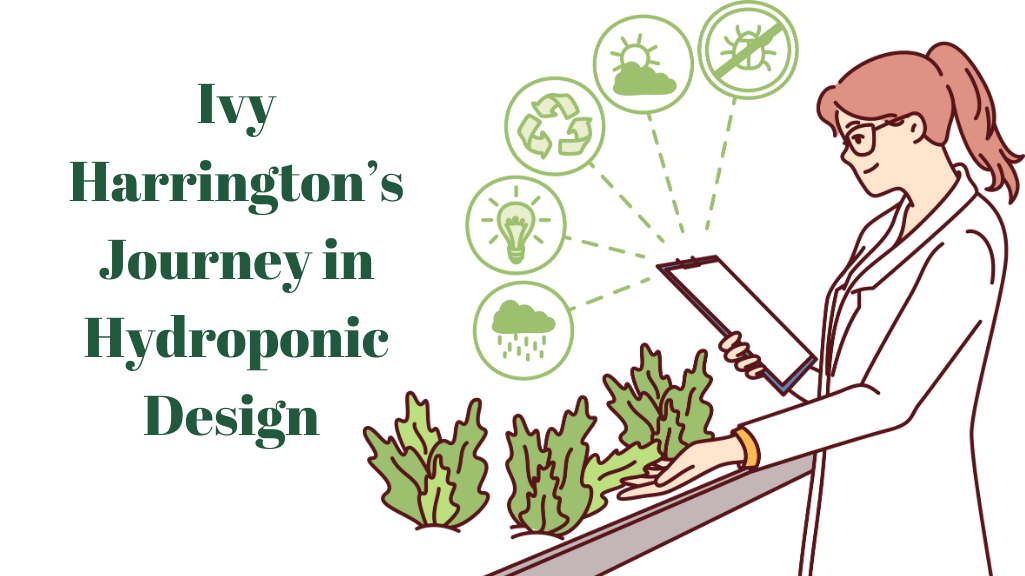Having grown up amidst the wet weather and endless greenery of the Pacific Northwest, Ivy had an early appreciation for green spaces. Her hometown region was one that was endowed with both fertile agricultural lands and bustling urban developments, and she was witness to the delicate balance between city and nature. She recalls Saturday mornings spent accompanying her parents to local farmers’ market spaces that contributed to instilling in her a love for fresh foods and locally based agriculture.
When other children her age were playing in treehouses, Ivy was designing grand gardens. She’d render drawings with window boxes and vertical gardens, envisioning new ways to help people introduce fresh food into even the smallest inhabited spaces. This interest in design prompted her to take architecture in high school electives, where she was introduced to the idea of hydroponics during a lesson on green building methods.
Combining Art, Design, and Hydroponics
Ivy first studied interior design, believing her calling was to create beautiful spaces to live in. But once she discovered green architecture and sustainable design, the more she wondered about agriculture, particularly the prospect of plants being grown without the use of soil. She was captivated by tales of transforming old warehouse buildings into vertical farms, and she started experimenting on her own scale: mini hydroponic herb kits in her college dorm room or recycled plastic bottles as a hanging cascade of edible leaves in front of her single window.
Friends remember that when other interior design students were experimenting with paint swatches, Ivy was combining LED light ratios and nutrient solutions to cultivate basil and lettuce indoors.
Her bedroom shimmered with the gentle buzz of grow lights, a reflection of her conviction that form and function were not mutually exclusive. This was the essence of what she would eventually call “hydroponic decor”, a synthesis of contemporary design and effective plant cultivation, with the ultimate goal of transforming living spaces into lush, food-yielding environments.
Making a Mark at Hydroponics360
Following graduation, Ivy was straddling two worlds, the fast-paced world of design and the nascent world of urban agriculture. She posted her early experiments online, showing how form and function could be combined in handcrafted light rigs or trellis systems built from reclaimed wood. Editors at Hydroponics 360 found her entries and noticed her ability to bring creativity to functional hydroponic installations.
What started out as occasional guest columns quickly turned into a weekly column. Ivy’s writing expresses her dual passion: though her columns get into the science of achieving proper pH balance or algae management in closed systems, they also reveal her underlying conviction that food production can be a positive, creative endeavor. She frequently invites readers to view their hydroponic systems as living art that can illuminate even the smallest apartment or office cubicle.
Building Community through Sustainable Design
The hallmark of Ivy is her emphasis on community projects. She regularly works with local schools, bringing classroom-ready hydroponic installations to educate kids about biology and sustainability. In her writing, she spotlights nonprofit groups that have utilized hydroponics to revitalize empty lots or bring fresh vegetables to produce-deprived neighborhoods.
A strong proponent of resource sensitivity, Ivy promotes the use of sustainable materials, water-conserving methods, and recycled containers wherever possible. Ivy reiterates a theme from her work: beauty can inspire action. A lovely grow tower may be more than an office conversation starter in a coworking facility—it could be the start of a revolution, encouraging coworkers to attempt small-scale farming on their own. The more aesthetically pleasing these systems are, the more people will want to incorporate them into their offices and homes on a permanent basis.
Looking Ahead
In a world where populations are increasing and natural resources need to be used more intelligently, Ivy Harrington is all about potential. She keeps pushing the envelope by creating new solutions that blend technology, artful craftsmanship, and the simple passion for growing healthy food. With her work at Hydroponics 360, Ivy is furthering the hydroponics discussion, envisioning a day when sustainable, soilless growing is the status quo, and every hydroponic system is as beautiful as it is bountiful.
Finally, Ivy’s experience still stands as a testament to where beauty and innovation intersect in agriculture. By opening up her design and process, she encourages us all—design enthusiasts, urban gardeners, and hardcore hydroponics hobbyists alike—to rethink our own spaces and to see that food production can be functional and also beautiful. As she says, “A hydroponic system isn’t just plants in water—it’s a living installation that brings us closer to nature, even in the heart of a city.”
